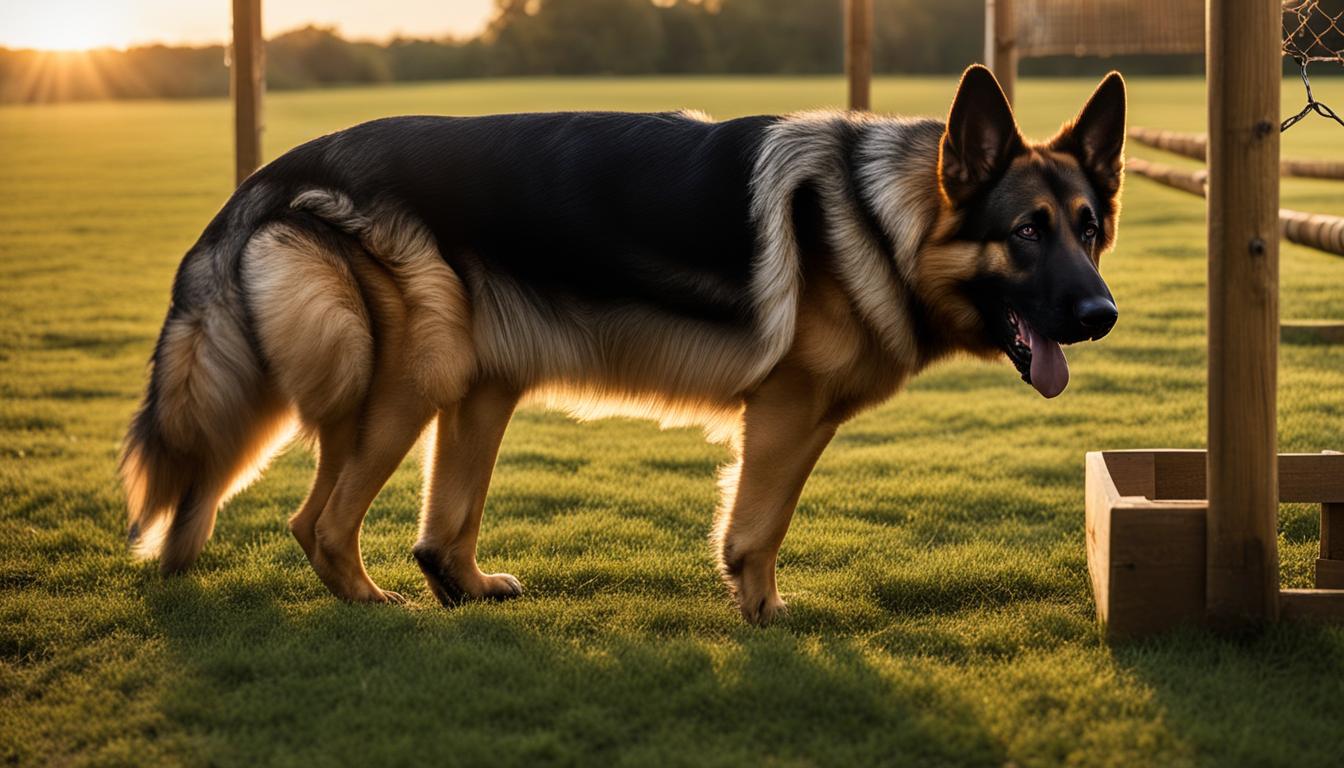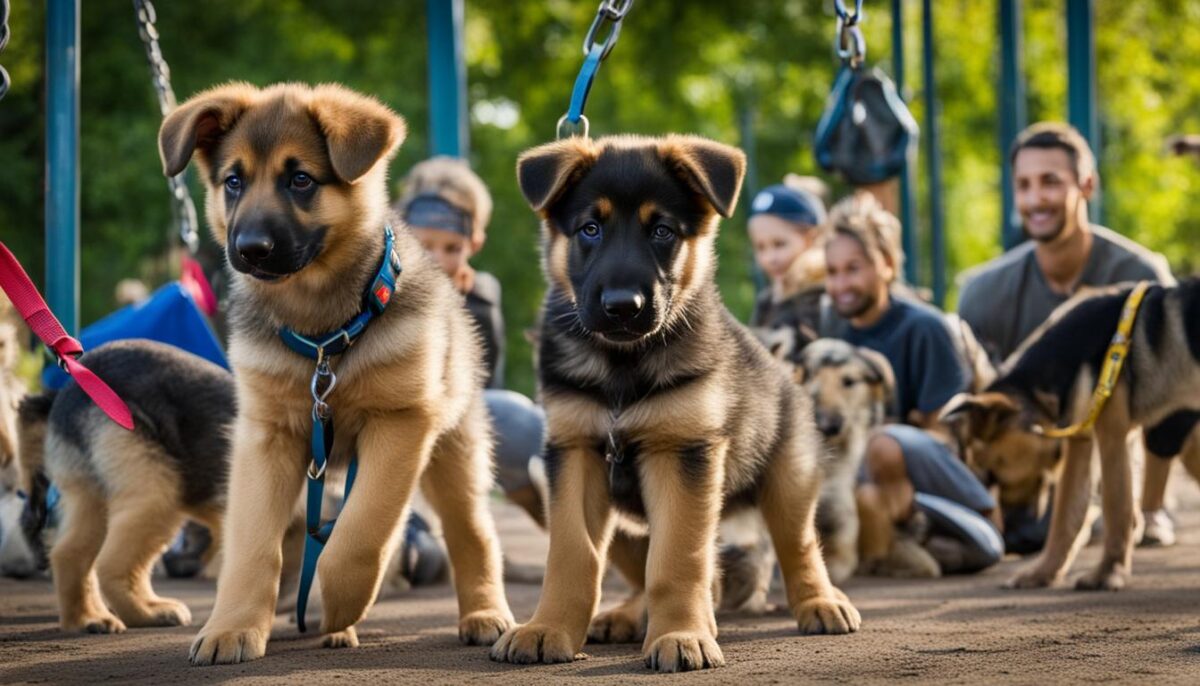If you have a dog at home, you might think about training them to keep your house safe. When you train a guard dog, you’re teaching them to watch over your home and let you know when someone is there. Training a guard dog is not the same as teaching a dog to fight. A guard dog will bark or growl to tell you if someone is there, but they won’t hurt anyone on their own.
Home security is important, and having protective dogs can help make your family feel safe. But remember, even if your dog is keeping an eye on things, they still need to listen and follow rules. This is what we call obedience training, and it helps your dog know what to do.
Key Takeaways
- Find out how to make your dog a good guard dog that keeps your home safe.
- Learn the difference between guard dogs and dogs that fight.
- Guard dogs bark to tell their family about strangers, but they shouldn’t be mean.
- Treats and saying “good job” can help your dog learn how to guard.
- It’s important to have your dog play with other people so they can be friendly and brave.
- Training your dog often and in different places helps them learn better.
Understanding the Role of Guard Dogs vs. Attack Dogs
When you think about guard dogs and attack dogs, they seem similar, but they’re really different. Guard dog traits make them great for watching your house and keeping you safe. They’re not like attack dogs, which help the police and may bite if they need to. Instead, guard dogs are about protective behavior and making sure strangers know to stay away.
The Characteristics that Define a Guard Dog
A really good guard dog is tough enough to scare off trouble but still listens to its human friends. These dogs have to know when it’s okay to be firm and when to be friendly, especially when they meet new people who are friends with their owner. Their dog obedience is super important because it means they can be tough without being mean.
Identifying Suitable Breeds for Guard Dog Training
Some dog breeds are famous for being good guard dogs. Have you heard of German Shepherds or Dobermans? They’re known for their guard dog breed characteristics, but really, any dog that shows the right kind of behavior can become a good guard dog. It’s not about where they come from; it’s about how they act and listen.
The Temperament and Social Traits of an Effective Guard Dog
A guard dog needs to be kind and calm, so they don’t get scared and do something they shouldn’t. Teaching them to be protective dogs means helping them learn to bark at strangers to warn them, but not to bite. These dogs should be okay with going new places and seeing new faces. Dog socialization is key—it’s when you help your dog learn to be nice to new people by giving them treats and happy pats for good behavior.
Next, let’s learn about some of the breeds that do really well when learning to guard and protect.
| Dog Breed | Good for Guarding? | Why They’re Good |
|---|---|---|
| German Shepherd | Yes | Smart and Loyal |
| Doberman Pinscher | Yes | Alert and Strong |
| Bulldog | No | Too Friendly, Not Alert Enough |
| Mixed Breed | Maybe | Depends on guard dog temperament |
Keep in mind, any dog with the right temperament and love for you can become a great guard dog with some training and love.
How to Train a Guard Dog
Training a guard dog starts when they are just a little puppy. It’s important for the puppy to learn about different places and meet lots of people. This helps them to be a good guard dog when they grow up. When they do something good, like being nice to a new person, you should give them a treat. This teaches them that they are doing the right thing.
Early Socialization and Its Impact on Guard Dog Behavior
When a puppy is between 3 and 12 weeks old, that’s the best time to start puppy socialization. Take your puppy to new places and let them see new faces. If they act friendly and not scared, say “good job” and give them a yummy treat. This helps the puppy to grow up into a brave and smart guard dog.
Basic Obedience Skills that Form the Foundation of Training
Before your dog can start learning guard dog upbringing, they should know simple things like “sit” and “stay”. This is part of dog training basics. Dogs like to have jobs to do, and doing these dog obedience skills gets them ready for more learning.
Establishing Commands and Trigger Words for Alerting
Command training is teaching your dog special words, or dog commands, to do things. To get your dog to bark at strangers, use a word like “speak”. Give them a treat when they make noise. This is called alert training. It helps your dog know when to tell you if someone comes to the door.
Practice and Consistency in Command Execution
Keep practicing the “speak” command. Try it in your yard, on walks, and inside your house. Always give a treat right after they bark. This reinforcement in dog training makes them remember the command better. But, don’t make them practice too much. If they get too tired or cranky, they might not want to learn anymore.
Advanced Training Scenarios to Test Your Dog’s Skills
When your dog is really good at the “speak” command, it’s time for advanced dog training. Have someone your dog doesn’t know pretend to be a stranger. See if your dog barks when they come near. This is part of guard dog scenarios. It checks if your dog knows how to be a guard dog in real life.
Remember, always be kind and have fun while teaching your dog new training exercises. This makes learning good for both you and your dog.
Conclusion
Having a guard dog that is well-trained is important for keeping your home safe. It is a big job but worth it when you have a dog that knows how to look after you and your place. This is what we call guard dog training success. It’s when your dog knows exactly what to do to keep bad folks away. But the best part is, they are nice to the good people in your life.
Your guard dog should show protective dog behavior without being too rough unless they need to be. Stick with the training and spend plenty of time teaching them the right from wrong. As days go by, your four-legged friend will become smarter and more aware of how to guard you and your home, making sure you both feel safe and sound.
And one last tip: when your guard dog knows how to take care of your home, let people know. You can put up signs that say things like “Beware of Dog.” This tells people that you have a special dog that has learned to protect your secure home. And they will be careful. This is good for everyone and helps keep the peace.
FAQ
What’s the difference between training a guard dog and an attack dog?
Training a guard dog focuses on teaching the dog to warn its owner with barks or growls when unknown people are around, without attacking. In contrast, attack dogs are trained for police work where they may be required to attack on command.
What traits should I look for in a good guard dog?
A good guard dog should be protective but not aggressive, have the ability to stand its ground without being pushy, and be comfortable with new people in the presence of its owner.
Can any dog breed be trained to be a guard dog?
Yes, while breeds like German Shepherds and Dobermans are well-known for their guarding abilities, any dog, including mixed breeds, can be trained to guard if they have the right temperament and behavior traits.
How can I ensure my guard dog remains friendly and not too aggressive?
It’s important to socialize your dog properly by exposing them to new people and environments in a positive manner. Rewarding them for calm behavior and using reinforcement during training helps maintain their friendliness.
At what age should I start socializing my dog?
You should start exposing your puppy to new people, places, and experiences as early as 3 to 12 weeks old. This early socialization helps them become well-adjusted adults.
What are the foundational commands my dog should know before starting guard dog training?
Your dog should be well-versed in basic obedience commands such as “sit” and “stay.” These basic skills are essential for effective guard dog training.
How do I teach my dog to bark on command as a warning?
To teach the “bark” or “speak” command, you can use repetitive training sessions where you encourage your dog to bark and reward them with treats when they do so. Gradually associate the action with the command word and practice in different settings.
How much training practice should my guard dog get?
While regular practice is crucial, it’s important not to overdo it. Training sessions should be kept short and enjoyable to prevent your dog from becoming tired or upset. Consistency and incremental progress are key.
How can I test my dog’s guard training skills?
You can conduct advanced training scenarios, such as having a family member act as a stranger approaching the door, to test whether your dog will appropriately bark and alert you without showing unnecessary aggression.
What precautions should I take once my dog is trained to guard?
Always assure that your trained guard dog is not a danger to others by maintaining consistent training and placing warning signs such as “Beware of Dog” to alert visitors of your dog’s protective nature.

